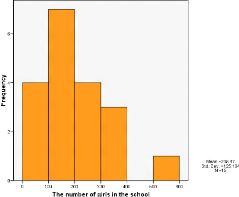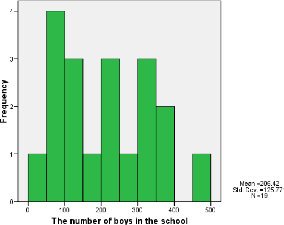4.3.5 Equity
Equity issues in private schools in Kibera are, according to
our study, taken with the highest level of importance. The fact that the
businesses operate in slums and cater for low income families is to an extent
the sign of their wanting to implicate all categories of people into education.
As the research presents it, Kibera is a large slum with a massive number of
poor children living altogether. The school owners tackle equity issues from
different perspectives allowing those from families where there is no income,
or no parents have access to education alongside those who can afford the fees
and have a more stable family life.
4.3.5.1 Opportunities
The private schools in Kibera play a fundamental role in
filling the gaps created by educational needs in this community due to the
growing number of people. By offering less expensive education to those who can
afford and by allocating special funds in the form of scholarship to a
particular group of pupils as stated earlier, many children of the slum are
given chances to participate in the school systems and do benefit from the
advantages offered by the schools. In addition to this financial support
ranging from £4 to close to £397 in very rare instances (see table
7). School owner A (Dagoretti Youth centre) stresses on some of the important
issues which are applied in his institution in order for all the students to
feel that they are treated equally and comfortable. Among these are:
- A flexible admission criteria for all the students irrespective
of their age and social background;
- A child friendly approach within the daily relationship with
pupils;
- Free extra coaching for slow learners;
- Home visit follow ups for children in the community.
For some other institutions like school G (Mukuni community
centre) school F (Zafarani School) and school I (Future Kids academy), specific
emphasis is being laid on lower and affordable school fees to all as well as
free teaching /learning materials. Other benefits include the teaching of civic
education and free immunization campaigns against some diseases.
Table 7: Orphans' financial support
The amount offered for orphans
|
Frequency
|
Percent
|
Valid Percent
|
Cumulative
Percent
|
|
Valid 0
|
7
|
35.0
|
35.0
|
35.0
|
|
4
|
2
|
10.0
|
10.0
|
45.0
|
|
8
|
1
|
5.0
|
5.0
|
50.0
|
|
8
|
3
|
15.0
|
15.0
|
65.0
|
|
12
|
1
|
5.0
|
5.0
|
70.0
|
|
40
|
1
|
5.0
|
5.0
|
75.0
|
|
71
|
1
|
5.0
|
5.0
|
80.0
|
|
103
|
2
|
10.0
|
10.0
|
90.0
|
|
397
|
2
|
10.0
|
10.0
|
100.0
|
|
Total
|
20
|
100.0
|
100.0
|
|
All these factors put together contribute significantly to
alleviating the cost of educational provision in these non formal settings of
Kibera. It equally makes the learning environment attractive to many pupils and
parents who for some reasons feel excluded.
4.3.5.2 Gender
On a similarly important note of equity, is the gender issue.
That is the education of both male and female pupils in equal proportions. The
girl's education in the slums of Kibera is a priority and the private schools
that operate in this environment in their rallying policies do well in
promoting this trend. Even though our study did not particularly looked at this
issue from a separate angle, the statistics for pupils enrolments in the 20
schools that took part in to the study actually show an overall satisfactory
result. Girls' enrolments in private schools in the slum of Kibera for this
academic year substantiate this speculation. From the enrolment statistics of
19 schools out of the 20, girls' enrolment range from minimum of 47 pupils to
a
maximum of 560 pupils, with a mean of 205.47 while boys'
enrolment ranged from a minimum of 38 pupils to a maximum of 470 and a mean of
206.42 (see tables 8&9). The following figures and tables illustrate these
relative equitable enrolments for boys and girls in private schools catering
for the poor in Kibera, Kenya. In a nutshell girls are given the same learning
opportunities in the slum.
Figure 7: Number of girls in the 20 schools this
year

Table 8: Girls in school
Descriptive Statistics
|
N
|
Minimum
|
Maximum
|
Mean
|
Std. Deviation
|
|
The number of girls in the school Valid N (listwise)
|
19
19
|
47
|
560
|
205.47
|
125.104
|
Table 9: Boys in school

Figure 8: The number of boys in the 20
schools

Another important aspect of the gender issue in the private
school provision in Kibera is related to the employability of the staff. The
study in five specific schools reveals that women are equally given high esteem
when it comes to teaching. In fact out of the 25 teachers, 12 were female and
13 male. This fact stresses the equal opportunities scheme that is applied by
the entrepreneurs while recruiting staff into their institutions.
Figure 9 Teachers' gender

| 

